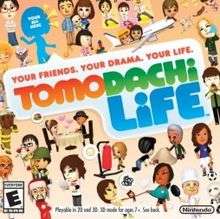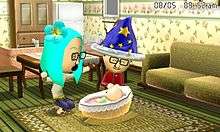Tomodachi Life
| Tomodachi Life | |
|---|---|
 North American box art | |
| Developer(s) | Nintendo SPD |
| Publisher(s) | Nintendo |
| Director(s) |
Noriyuki Sato Ryutaro Takahashi Eisaku Nakae |
| Producer(s) | Yoshio Sakamoto |
| Composer(s) |
Daisuke Matsuoka Asuka Ito |
| Platform(s) | Nintendo 3DS |
| Release | |
| Genre(s) | Life simulation |
| Mode(s) | Single-player |
Tomodachi Life[lower-alpha 1] is a life simulation video game developed by Nintendo SPD and published by Nintendo for the Nintendo 3DS. The game, which is a direct sequel to the Japan-exclusive Nintendo DS title, Tomodachi Collection, was released in Japan in April 2013, and worldwide in June 2014.(disincluding ROK was released in July) Along with good sales records, the game received positive reviews. Many reviewers praised the gameplay, but criticized the minigames.
The game also features five special Mii QR codes of celebrities that were released before the game was. The Miis include Shaquille O'Neal, Christina Aguilera, Shaun White, Debby Ryan, and Zendaya.
Gameplay
The game begins with the player naming their island and creating or importing their personal Mii, which is the player's "look-alike", who lives in a tiny apartment building. The building can grow, allowing the player to have 100 Miis on the island.

The game takes place on an island inhabited by various Miis, which the player can import from their 3DS, 2DS, 3DS XL and other devices, or QR codes, or create from scratch using the 3DS's camera or the in-game creation tools. These Miis can be given their own voice, which is spoken in vocal synthesizer software, and a unique personality based on slider inputs. Miis can then perform various actions, such as eating, trying on different outfits, falling in love with someone, and many leisure activities. As more Miis are introduced, many strange and curious interactions can occur between Miis, such as friendship, romance, rivalry, relationships, and families. As the game goes by, the player unlocks more and more stores, clothes, and food.
Development
In May 2014, a playable demo of the game was distributed to Platinum members of Club Nintendo in North America, the data of which could be transferred to the final version and unlock a bonus in-game item.[1] The game will be bundled with two Nintendo eShop download codes for a 'Welcome version' demo, which can be given to friends.[2] A slightly different demo version was later publicly released for download via the Nintendo eShop. This version does not unlock any features in the full game.
Following the game's announcement for a Western release, controversy arose concerning how it is not possible to have same-sex relationships in-game. Nintendo stated, "The ability for same-sex relationships to occur in the game was not part of the original game that launched in Japan, and that game is made up of the same code that was used to localise it for other regions outside Japan." [3] In May 2013, it was widely reported by the Western games media that a bug in the original Japanese version of Tomodachi Collection: New Life, which would allow users to have same-sex relationships, was patched by Nintendo.[4] This was refuted by Nintendo in a statement made April 2014, explaining that same-sex relationships were never possible, and that the patch in fact fixed a different issue.[5] Despite various campaigns from users, Nintendo stated that it would not be possible to add same-sex relationships to the game, as they "never intended to make any form of social commentary with the launch of" the game,[6] and because it would require significant development alterations which would not be able to be released as a post-game patch. The company later apologized and stated that, if they were to create another entry in the Tomodachi series, they would "strive to design a gameplay experience from the ground up that is more inclusive, and better represents all players."[7]
Reception
Tomodachi Life has received positive reviews. It holds an average of 72% and 71/100 on review aggregate sites GameRankings and Metacritic, respectively.[8][9][10] IGN gave the game a score of 8.4, calling it "a surprisingly funny and rewarding experience."[11] Polygon gave Tomodachi Life a 7.5 out of 10, praising its likeability despite certain aspects being repetitive.[12] GamesRadar gave the game 4 out of 5 stars, praising its weird humor and relaxing gameplay, whilst criticising the minigames for being too simple.[13] GameTrailers gave the game a score of 6.0, stating "the pervasive sense of quirkiness in Tomodachi Life works, but can’t sustain the entire game."[14] The game has received criticism for not enabling relationships between Mii characters of the same sex; Nintendo of America later apologized for failing to include same-sex relationships in Tomodachi Life, stating that it wasn't possible for NoA to change the game's design, or for Nintendo to change this aspect in a post-ship patch. It also noted that "if we create a next installment in the Tomodachi series, we will strive to design a game-play experience from the ground up that is more inclusive, and better represents all players."[15][16]
Tomodachi Life was the best seller in the Japanese video game market during the week of its release, selling about 404,858 units.[17] By September 2014, its global sales reached 3.12 million units.[18] As of June 30, 2018, Nintendo has sold 6.25 million units of the game worldwide.[19]
Legacy
A stage based on Tomodachi Life appears in Super Smash Bros. for Nintendo 3DS and Super Smash Bros. Ultimate.[20] Miitomo, a social networking mobile app for iOS and Android devices, was released in March 2016. The app was created by the same core team who developed Tomodachi Life, and features very similar ideas. In 2016, a similar game involving Miis, Miitopia, was released in Japan.[21] It was released worldwide the following year.
Notes
References
- ↑ "Club Nintendo Distributing Tomodachi Life Demo Codes to Select Platinum Members - 3DS News @ Nintendo Life". Nintendolife.com. Retrieved May 21, 2014.
- ↑ MacDonald, Keza (May 21, 2014). "Tomodachi Life Comes With 2 Free Demos to Give to Friends". Kotaku UK. Retrieved May 21, 2014.
- ↑ "Nintendo resists #Miiquality campaign to let Tomodachi Life gamers play gayk=Guardian News". Associated Press. May 7, 2014.
- ↑ Ashcraft, Brian (May 8, 2013). "Rumor: Bug Makes Gay Marriage Possible in Nintendo Game [Update]". Kotaku.com. Retrieved June 12, 2014.
- ↑ Parfitt, Ben (April 10, 2014). "VIDEO: Nintendo to give Tomodachi Life a shot in the West | Games industry news | MCV". MCV. Retrieved June 7, 2018.
- ↑ lang, Derrik (May 7, 2014). "Nintendo Says No to Virtual Equality in Life Game". Associated Press. Abcnews.go.com. Archived from the original on May 12, 2014. Retrieved May 21, 2014.
- ↑ "We are committed to fun and entertainment for everyone - Nintendo Official Site". Nintendo.com. May 9, 2014. Retrieved May 10, 2014.
- ↑ "Tomodachi Life for 3DS". GameRankings. CBS Interactive. Retrieved February 8, 2017.
- ↑ "Tomodachi Life for 3DS Reviews". Metacritic. CBS Interactive. Retrieved June 8, 2014.
- ↑ "Nintendo Apologizes For Not Putting Gay Marriage In Tomodachi Life". Kotaku. Kotaku. Retrieved June 8, 2014.
- ↑ Otero, Jose (June 6, 2014). "Tomodachi Life Review". IGN. Retrieved June 8, 2014.
- ↑ McElroy, Griffin (June 6, 2014). "Tomodachi Life review: semi charmed". Polygon. Retrieved June 6, 2014.
- ↑ Gilbert, Herbert (June 6, 2014). "Tomodachi Life review". GamesRadar. Retrieved June 8, 2014.
- ↑ Moore, ben (June 6, 2014). "Tomodachi Life - Review". GameTrailers. Retrieved June 8, 2014.
- ↑ "Nintendo Apologizes For Omitting Gay Marriage From 'Tomodachi Life'". NBC News.
- ↑ Jason Schreier. "Nintendo Apologizes For Not Putting Gay Marriage In Tomodachi Life". Kotaku. Gawker Media.
- ↑ "This Week in Sales: Tomodachi Collection Sees Big Launch Sales". Siliconera. April 24, 2013. Retrieved February 2, 2014.
- ↑ "Supplementary Information about Earnings Release" (PDF). Nintendo. October 30, 2014. Retrieved November 29, 2014.
- ↑ "Top Selling Software Sales Units - Nintendo 3DS Software". Nintendo. March 31, 2018. Retrieved April 26, 2018.
- ↑ "Tomodachi Collection: New Life stage". IGN. March 14, 2014. Retrieved March 30, 2014.
- ↑ Otero, Jose. "5 Things We Learned About Miitomo and Nintendo's Digital Future". IGN. Retrieved 1 April 2016.